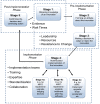Factors affecting the implementation of complex and evolving technologies: multiple case study of intensity-modulated radiation therapy (IMRT) in Ontario, Canada
- PMID: 21801450
- PMCID: PMC3164623
- DOI: 10.1186/1472-6963-11-178
Factors affecting the implementation of complex and evolving technologies: multiple case study of intensity-modulated radiation therapy (IMRT) in Ontario, Canada
Abstract
Background: Research regarding the decision to adopt and implement technological innovations in radiation oncology is lacking. This is particularly problematic since these technologies are often complex and rapidly evolving, requiring ongoing revisiting of decisions regarding which technologies are the most appropriate to support. Variations in adoption and implementation decisions for new radiation technologies across cancer centres can impact patients' access to appropriate and innovative forms of radiation therapy. This study examines the key steps in the process of adopting and implementing intensity modulated radiation therapy (IMRT) in publicly funded cancer centres and identifies facilitating or impeding factors.
Methods: A multiple case study design, utilizing document analysis and key informant interviews was employed. Four cancer centres in Ontario, Canada were selected and interviews were conducted with radiation oncologists, medical physicists, radiation therapists, and senior administrative leaders.
Results: Eighteen key informants were interviewed. Overall, three centres made fair to excellent progress in the implementation of IMRT, while one centre achieved only limited implementation as of 2009. Key factors that influenced the extent of IMRT implementation were categorized as: 1) leadership, 2) training, expertise and standardization, 3) collaboration, 4) resources, and 5) resistance to change.
Conclusion: A framework for the adoption and implementation of complex and evolving technologies is presented. It identifies the key factors that should be addressed by decision-makers at specific stages of the adoption/implementation process.
Figures



Similar articles
-
IMRT utilization in Ontario: qualitative deployment evaluation.Int J Health Care Qual Assur. 2014;27(8):742-59. doi: 10.1108/ijhcqa-12-2013-0140. Int J Health Care Qual Assur. 2014. PMID: 25417379
-
Intensity-modulated radiotherapy: current status and issues of interest.Int J Radiat Oncol Biol Phys. 2001 Nov 15;51(4):880-914. doi: 10.1016/s0360-3016(01)01749-7. Int J Radiat Oncol Biol Phys. 2001. PMID: 11704310 Review.
-
Multi-level factors influence the implementation and use of complex innovations in cancer care: a multiple case study of synoptic reporting.Implement Sci. 2014 Sep 16;9:121. doi: 10.1186/s13012-014-0121-0. Implement Sci. 2014. PMID: 25224952 Free PMC article.
-
Adoption of an innovation to repair aortic aneurysms at a Canadian hospital: a qualitative case study and evaluation.BMC Health Serv Res. 2007 Nov 15;7:182. doi: 10.1186/1472-6963-7-182. BMC Health Serv Res. 2007. PMID: 18005409 Free PMC article.
-
Organisational standards for the delivery of intensity-modulated radiation therapy in Ontario.Clin Oncol (R Coll Radiol). 2009 Apr;21(3):192-203. doi: 10.1016/j.clon.2008.10.005. Epub 2008 Dec 5. Clin Oncol (R Coll Radiol). 2009. PMID: 19062263 Review.
Cited by
-
Implementation of intensity modulated radiotherapy for prostate cancer in a private radiotherapy service in Mexico.Rep Pract Oncol Radiother. 2014 Dec 12;20(1):66-71. doi: 10.1016/j.rpor.2014.06.002. eCollection 2015 Jan. Rep Pract Oncol Radiother. 2014. PMID: 25535587 Free PMC article.
-
Factors Influencing the Adoption of Magnetic Resonance-Guided High-Intensity Focused Ultrasound for Painful Bone Metastases in Europe, A Group Concept Mapping Study.Int J Environ Res Public Health. 2023 Jan 7;20(2):1084. doi: 10.3390/ijerph20021084. Int J Environ Res Public Health. 2023. PMID: 36673840 Free PMC article.
-
Can automated treatment plans gain traction in the clinic?J Appl Clin Med Phys. 2019 Aug;20(8):29-35. doi: 10.1002/acm2.12674. Epub 2019 Jul 16. J Appl Clin Med Phys. 2019. PMID: 31313508 Free PMC article.
-
A national survey of the availability of intensity-modulated radiation therapy and stereotactic radiosurgery in Canada.Radiat Oncol. 2012 Feb 7;7:18. doi: 10.1186/1748-717X-7-18. Radiat Oncol. 2012. PMID: 22309806 Free PMC article.
-
Artificial intelligence in radiation oncology: A specialty-wide disruptive transformation?Radiother Oncol. 2018 Dec;129(3):421-426. doi: 10.1016/j.radonc.2018.05.030. Epub 2018 Jun 12. Radiother Oncol. 2018. PMID: 29907338 Free PMC article. Review.
References
MeSH terms
LinkOut - more resources
Full Text Sources

